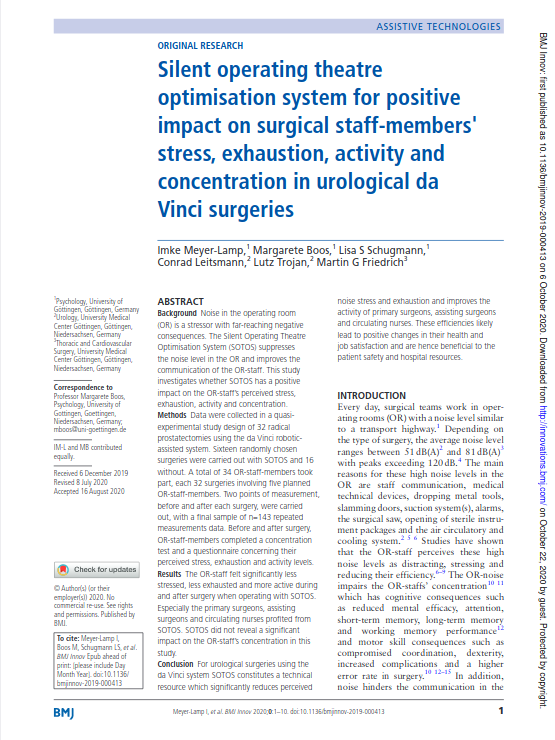Silent operating theatre optimisation system for positive impact on surgical staff-members' stress, exhaustion, activity and concentration in urological da Vinci surgeries
 Abstract
Abstract
BackgroundNoise in the operating room (OR) is a stressor with far-reaching negative consequences. The Silent Operating Theatre Optimisation System (SOTOS) suppresses the noise level in the OR and improves the communication of the OR-staff. This study investigates whether SOTOS has a positive impact on the OR-staff’s perceived stress, exhaustion, activity and concentration.MethodsData were collected in a quasi-experimental study design of 32 radical prostatectomies using the da Vinci robotic-assisted system. Sixteen randomly chosen surgeries were carried out with SOTOS and 16 without. A total of 34 OR-staff-members took part, each 32 surgeries involving five planned OR-staff-members. Two points of measurement, before and after each surgery, were carried out, with a final sample of n=143 repeated measurements data. Before and after surgery, OR-staff-members completed a concentration test and a questionnaire concerning their perceived stress, exhaustion and activity levels.ResultsThe OR-staff felt significantly less stressed, less exhausted and more active during and after surgery when operating with SOTOS. Especially the primary surgeons, assisting surgeons and circulating nurses profited from SOTOS. SOTOS did not reveal a significant impact on the OR-staff’s concentration in this study.ConclusionFor urological surgeries using the da Vinci system SOTOS constitutes a technical resource which significantly reduces perceived noise stress and exhaustion and improves the activity of primary surgeons, assisting surgeons and circulating nurses. These efficiencies likely lead to positive changes in their health and job satisfaction and are hence beneficial to the patient safety and hospital resources.
File: Type PDF / Size: 1 MB/ Download
